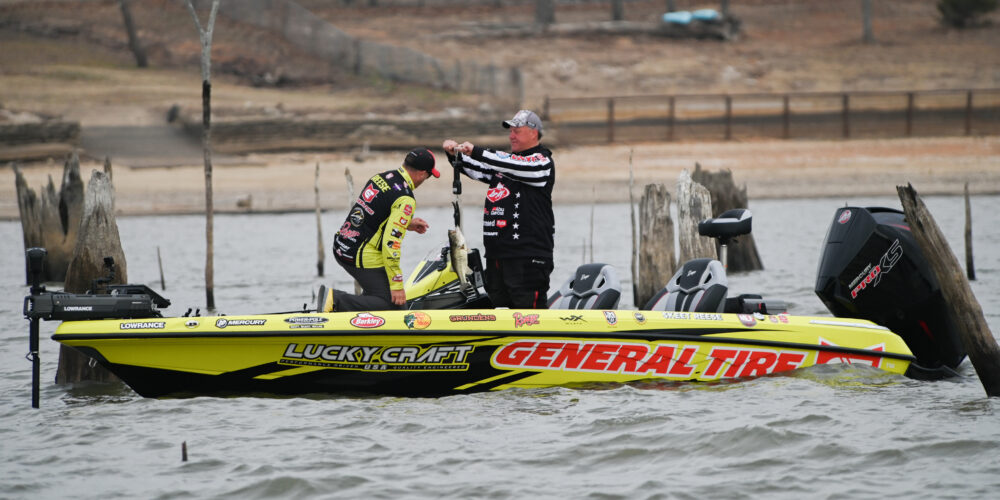Basing Bass Size Standards on Science
How MLF FMD research guides Bass Pro Tour’s scorable bass minimums

Long before the schedule is announced for each Bass Pro Tour Stage, the Major League Fishing Fisheries Management Division (FMD) in partnership with Berkley Labs has already analyzed data sets that contain hundreds of bass for each fishery the tour will visit. Our process starts by contacting the state fisheries biologist who manages each individual fishery and obtaining a raw data set from each fishery that contains the past several years of sampling data.
What we get back leads us down a unique road that ends with a recommendation to a committee that determines Minimum Scorable Bass weights for each Bass Pro Tour event.
The Baseline for Data Collection
It may surprise you to find out that there’s no real national standard for how often a fishery is sampled or what types of data are collected. Instead, every state has individual plans and procedures statewide (or in a few cases, a plan for each individual fishery).
The primary sampling method state agencies use to collect black bass species is electrofishing. This is usually done using random plot generation on a map to select sites. Each site is then electrofished for a specific amount of time, collecting all fish species observed. In some fisheries, we also receive data that targets black bass over other species, or in locations that are determined in a non-random fashion.
The frequency of electrofishing for each fishery could be anything from twice a year to once every other year or longer. This is highly dependent on the management plan in place for the fishery and its popularity among anglers. For example, more popular reservoirs like Lake Fork will be sampled more often than a lesser-known fishery. Regardless of random or non-random electrofishing – or targeted or nontargeted surveys – once a fish is caught by a sampling crew, data is collected for that fish. But, once again, what’s collected varies from state to state. Lengths may be collected in millimeters, centimeters, or inches, and weights may be in kilograms, grams, pounds, or not collected at all.
Breaking Down the Data
As you can imagine with the Bass Pro Tour visiting half a dozen or more states annually, we receive very diverse data sets. No matter what data the state biologist provides, our process at the FMD desk is always the same.
First, we filter all the data by species – largemouth, smallmouth and spotted bass are individually analyzed if they exist in the same fishery. Next, we must standardize length and weight, so we run the data set through formulas to give inches for length and total pounds for weight. Step three is to then sort the filtered data by length and remove all fish below legal size. For fisheries with a slot limit or special regulation, we’ll typically use the statewide standard-length limits.
The data set may start out covering the past five years with 3,000 fish, but typically when we remove non-legal-sized fish, we quickly get down below 1,000 legal fish in the data set. At this point we pause our data sorting and calculate the average weight of a barely legal fish, just to get a baseline for what the absolute minimum a legal fish weighs.
It may surprise you that the average weight of a 14-inch fish from one fishery to another may vary by as much as a quarter-pound. For example, a 14-inch fish at Lake Fork was 1.31 pounds, but at Lake Palestine it was 1.42 pounds.
Once we have the data standardized, sorted and all non-legal fish removed, we then group the fish by weight in quarter-pound increments. We calculate what percentage of legal fish in the data set fit into each weight class and finally total what percentage of the data set would be included if each weight class was the minimum scorable weight. We then replicate this for each species if that’s needed.
For example, at Lake Fork we started with a data set and filtered it down to 473 legal fish over 14 inches (which is the state regulation, not the slot limit used on the fishery). Of those legal fish, 90% were over 1.5 pounds, 70% were over 2 pounds, 62% were over 2.25 pounds, and 54% were over 2.5 pounds. This is the data we presented to the committee for selecting the Minimal Scorable Weight, along with a recommendation for exactly where we think the standard should be set for that fishery.
Making the Final Scorable-Bass Standard
Other members of the above-mentioned committee are anglers and league officials who might bring results from local tournament weigh-ins, their pre-practice experience, predictions on weather conditions or even our own SCORETRACKER® data from past events. The committee discusses our recommendations and compares this science-based approach to real-world experience to come up with the Minimum Scorable Weight. After one final vote, it’s set and we move on to the next season.
The key is that this process is happening well before the schedule is even announced. The goal is to make a real-time minimum weight determination that holds the Bass Pro Tour anglers to a higher standard than most comparable events on a given body of water. Sometimes we get it right. Other times, unpredictable conditions make our standard set too high. Regardless, the Minimum Scorable Weight is one of the many ways the Bass Pro Tour maintains a very high level of competition and the MLF Fisheries Management Division is happy to play a small role in making sure it’s based in science.